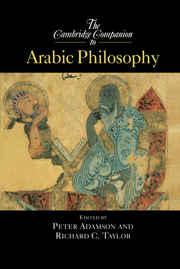Book contents
- Frontmatter
- 1 Introduction
- 2 Greek into Arabic
- 3 Al-Kindī and the reception of Greek philosophy
- 4 Al-Fāarābī and the philosophical curriculum
- 5 The Ismāīlīs
- 6 Avicenna and the Avicennian Tradition
- 7 Al-Ghazālī
- 8 Philosophy in Andalusia
- 9 Averroes
- 10 Suhrawardī and Illuminationism
- 11 Mysticism and philosophy
- 12 Logic
- 13 Ethical and political philosophy
- 14 Natural philosophy
- 15 Psychology
- 16 Metaphysics
- 17 Islamic philosophy and Jewish philosophy
- 18 Arabic into Latin
- 19 Recent trends in Arabic and Persian philosophy
- Select bibliography and further reading
- Index
17 - Islamic philosophy and Jewish philosophy
Published online by Cambridge University Press: 28 May 2006
- Frontmatter
- 1 Introduction
- 2 Greek into Arabic
- 3 Al-Kindī and the reception of Greek philosophy
- 4 Al-Fāarābī and the philosophical curriculum
- 5 The Ismāīlīs
- 6 Avicenna and the Avicennian Tradition
- 7 Al-Ghazālī
- 8 Philosophy in Andalusia
- 9 Averroes
- 10 Suhrawardī and Illuminationism
- 11 Mysticism and philosophy
- 12 Logic
- 13 Ethical and political philosophy
- 14 Natural philosophy
- 15 Psychology
- 16 Metaphysics
- 17 Islamic philosophy and Jewish philosophy
- 18 Arabic into Latin
- 19 Recent trends in Arabic and Persian philosophy
- Select bibliography and further reading
- Index
Summary
THE BEGINNINGS OF MEDIEVAL JEWISH PHILOSOPHY
The broadest periodization of medieval philosophy, in general, and of medieval Jewish philosophy, in particular, begins with Philo in the first century and comes to an end with Spinoza in the seventeenth century. This is the well-known periodization of Harry A. Wolfson, who explains:
[We[ describe this period as mediaeval, for after all it comes between a philosophy which knew not of Scripture and a philosophy which tries to free itself from Scripture, [so[ mediaeval philosophy is the history of the philosophy of Philo.
Wolfson was in a sense correct. The problems and concerns of Philo were to a great extent those of the medieval philosophers. Yet, while it is helpful to think of the philosophy of Philo as the “Foundations of Religious Philosophy in Judaism, Christianity, and Islam,” virtually all datings of medieval philosophy begin centuries later and in the case of medieval Jewish philosophy nearly a millennium later. The resistance of scholars to beginning medieval Jewish philosophy with Philo is not simply a result of their discomfort with beginning the medieval period in the first century. More importantly, if one begins medieval Jewish philosophy with Philo, there is no continuity. From Philo to the ninth century, there are no writings that may be considered Jewish philosophy. Moreover, although Wolfson can speak of the recurrence of Philonic views in post-Philonic Islamic and Jewish philosophy, Philo – as far as we know – was not translated into Arabic or Hebrew and accordingly had no direct influence upon Jewish philosophers until the Renaissance.
- Type
- Chapter
- Information
- The Cambridge Companion to Arabic Philosophy , pp. 349 - 369Publisher: Cambridge University PressPrint publication year: 2004
- 1
- Cited by



